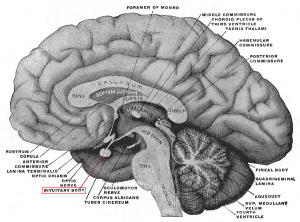Pituitary Gland
The Pituitary Gland, or Hypophysis in vertebrate anatomy is an endocrine gland (known as the "master" endocrine gland). In humans it is about the size of a pea and weighs 0.5 g (0.02 oz.). It is a protrusion off the bottom of the hypothalamus at the base of the brain, and rests in a small, bony cavity. This gland secretes nine hormones that regulate homeostasis.
According to H. P. Blavatsky this gland has an important role from an esoteric point of view:
There are seven cavities in the Brain . . . These cavities are called in Occultism the “Seven Harmonies,” the scale of the Divine Harmonies, and it is in these that visions must be reflected, if they are to remain in the Brain-memory. These are the parts of the Brain which receive impressions from the Heart, and enable the memory of the Heart to be impressed on the memory of the Brain.
The fourth of these cavities is the Pituitary Body, which corresponds with Manas-Antaskarana, the bridge to the Higher Intelligence; it contains various essences.[1]
The seven physical Nâdîs extend up the vertebral column from the sacrum to the atlas. The superphysical are within the head, and of these the fourth is the Pituitary Body.[2]
The Pituitary Body is the organ per se of the psychic plane. Pure psychic vision is caused by the molecular motion of this body, which is directly connected with the optic nerve, and thus affects the sight, and gives rise to hallucinations. Its motion may readily cause flashes of light, seen within the head, similar to those that may be obtained on pressing the eyeballs, and so causing molecular motion in the optic nerve. When molecular action is set up in the Pituitary Body these flashes are seen, and further action gives psychic vision, as similar motion in the Pineal Gland gives Spiritual Clairvoyance. Drunkenness and fever cause disorderly motion in the Pituitary Body, and so produce illusions of sight, visions, hallucinations. This body is sometimes so affected by drunkenness that it is paralyzed, and the strict forbiddance of alcoholic liquids to all students of Occultism turns on this effect which alcohol produces on the Pituitary Body and Pineal.[3]
The Pituitary Body is only the servant of the Pineal Gland, its torch-bearer, like the servants carrying torches that run before the carriage of a princess.[4]
Ājñā chakra
C. W. Leadbeater connected the pituitary gland to the ājñā chakra, the sixth center counting from below up, positioned at the eyebrow region. Although in Hinduism this chakra is traditionally considered as the "third eye", the Theosophical view disagrees. In the latter, the third eye is identified with the pineal gland, which Leadbeater connected to the seventh chakra.[5]
He described the brow chakra as follows:
The sixth centre, the frontal (Plate IX), between the eyebrows, has the appearance of being divided into halves, one chiefly rose-coloured, though with a great deal of yellow about it, and the other predominantly a kind of purplish-blue, again closely agreeing with the colours of the special types of vitality that vivify it. Perhaps it is for this reason that this centre is mentioned in Indian books as having only two petals, though if we are to count undulations of the same character as those of the previous centres we shall find that each half is subdivided into forty-eight of these, making ninety-six in all, because its primary force has that number of radiations.[6]
Regarding its function, Leadbeater wrote:
When the sixth [chakra], between the eyebrows, becomes vivified, the man begins to see things, to have various sorts of waking visions, sometimes of places, sometimes of people. In its earlier development, when it is only just beginning to be awakened, it often means nothing more than half-seeing landscapes and clouds of colour. The full arousing of this brings about clairvoyance.
The centre between the eyebrows is connected with sight in yet another way. It is through it that the power of magnification of minute physical objects is exercised. A tiny flexible tube of etheric matter is projected from the centre of it, resembling a microscopic snake with something like an eye at the end of it. This is the special organ used in that form of clairvoyance, and the eye at the end of it can be expanded or contracted, the effect being to change the power of magnification according to the size of the object which is being examined. This is what is meant in ancient books when mention is made of the capacity to make oneself large or small at will. To examine an atom one develops an organ of vision commensurate in size with the atom. This little snake projecting from the centre of the forehead was symbolized upon the head-dress of the Pharaoh of Egypt, who as the chief priest of his country was supposed to possess this among many other occult powers.[7]
Notes
- ↑ Helena Petrovna Blavatsky, Collected Writings vol. XII (Wheaton, IL: Theosophical Publishing House, 1980), 697.
- ↑ Helena Petrovna Blavatsky, Collected Writings vol. XII (Wheaton, IL: Theosophical Publishing House, 1980), 701.
- ↑ Helena Petrovna Blavatsky, Collected Writings vol. XII (Wheaton, IL: Theosophical Publishing House, 1980), 698.
- ↑ Helena Petrovna Blavatsky, Collected Writings vol. XII (Wheaton, IL: Theosophical Publishing House, 1980), 698.
- ↑ Charles Webster Leadbeater, The Chakras, (Wheaton, Ill: The Theosophical Publishing House, 1987), 10.
- ↑ Charles Webster Leadbeater, The Chakras, (Wheaton, Ill: The Theosophical Publishing House, 1987), 13-14.
- ↑ Charles Webster Leadbeater, The Chakras, (Wheaton, Ill: The Theosophical Publishing House, 1987), 79
